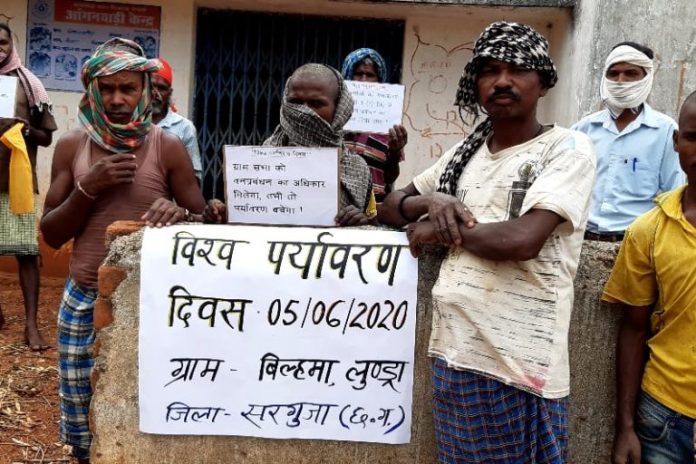
The Chhattisgarh government revised its May 28 order making the state forest department the nodal agency of the CFRR (community forest resource rights), which is under the Forest Rights Act, 2006, after drawing severe criticism from activists and tribal rights organisations.
According to studies, the implementation of the CFRR was deliberately brought under the jurisdiction of the Union Ministry of Tribal Affairs (MoTA) to ensure that recognition of tribals’ rights wouldn’t be affected by resistance from the forest department’s bureaucracy.
Alok Shukla, the convenor of the Chhattisgarh Bachao Andolan, an organisation working for the rights of tribals in the state, had termed the move of making the forest department as the nodal agency of the CFRR ‘unconstitutional’. Only the ministry or the department of tribal affairs can be made the nodal agency for CFRR, he stated, adding that it’s common knowledge that the forest department has been prejudiced in the implementation of the CFRR.
However, he stated that whether the real objective behind the new notification is to facilitate the actual and speedy realisation of people’s rights or to exercise control is yet to be seen. The state government should also ensure the speedy claims of the CFRR as about 200 such claims are still pending with the government, he added.
Another member of the Chhattisgarh Bachao Andolan, Kamal Shukla, alleged that the forest department was made the nodal agency only to curb the interests of gram sabha and it would have solved nothing. Though the tribal communities in Chhattisgarh haven’t been entirely happy with how the states’s tribal department is carrying out the CFRR implementation … the department is at least working for the welfare and development of the tribal people in close coordination with gram panchayats, and that’s why, the tribals have hope from it, added Kamal.
What is CFRR?
The Scheduled Tribes and Other Traditional Forest Dwellers (Recognition of Forest Rights Act), 2006 had aspired to undo the historic injustice meted out to forest-dependent communities due to curtailment of their customary rights over forests which resulted in their marginalisation and displacement. The Act recognises and vests the right to use, manage and conserve forest resources and to legally hold forest land that these communities have used for cultivation and residence in forest-dwelling communities. It also recognises the integral role that forest dwellers play in the survival and sustainability of forests and in the conservation of biodiversity.
The CFRR empowers the gram sabhas to regulate access to community forest resources and stop any activity which adversely affects the wild animals, forest and biodiversity.
According to a study in 2015, even though the tribal affair ministry is the nodal agency of the CFRR, the forest departments have either appropriated or given effective control over the FRA’s recognition process. This has created a situation where the officials controlling the implementation of the law often have the strongest interest in its non-implementation, especially of provisions which challenge the powers of the forest department, it added.
The study had also said that at least 40 million hectares of forest lands are eligible for the community forest rights recognition across the country. It had noted that at least 150 million people, including almost 90 million tribals, live in communities which would benefit from the CFRR.
Satyam Srivastava, a member of two committees constituted by the MoTA on habitat rights and community forest rights, told Mongabay-India that the forest department has been widely criticised because of its wrongdoing like booking forest dwellers for encroachment, not helping them with the CFRR and ousting people from the forests.
“The forest department today is more like a zamindar (landlord) who owns a large portion of land. There have been many cases in the past when forest dwellers were ousted by them … but when the denotification of a forest area was done, no action was taken by the forest department to bring those people back to their original settlement,” he added.
Srivastava emphasised that the state government should fix the responsibility and accountability of the state forest department first, instead of giving them an additional responsibility just under the garb of coordination. He highlighted that there was no need to make the forest department the nodal agency for CFRR as the department already enjoys a lot of power. “Watching their history, there is a huge possibility that the forest department may deny land rights to the tribal population living in the jungles of Chhattisgarh and may also try to control the forest rights and violate the Sections 3(1 and 2) of the Forest Rights Act”.
Role of gram sabhas in community forest rights
Ganga Ram Paikra, a Surguja-based tribal farmer and activist, mentioned that the government should have talked to farmers, tribals and community leaders before releasing such an order as the forest department has impacted the tribals severely.
“From booking them for encroachment to denying them the forest produce, the forest department has done it all … and thus this step would have never been accepted by the tribals of Chhattisgarh,” he said.
He added that if the forest department is the nodal agency, it would create obstacles in getting the verification of gram sabha projects.
Vijendra Aznabi, an activist with the Chhattisgarh Van Adhikaar Manch, a tribal forest-rights network alliance, stated that providing the CFRR to tribals was one of the electoral promises made by the Indian National Congress in 2018 before coming to power in the state and they implemented it but giving rights of the forest resources entirely to the community is a complex question for the ruling government.
He stressed that the state government doesn’t identify gram sabhas as an actual stakeholder in the CFRR. “The real fight is of the management of forests which should be in the hands of the gram sabha because the villagers are the real force behind the conservation of forests and everyone knows that the forest department has done more damage to the forests instead of conserving it,” he said.
Gautam Bandyopadhyay, a noted social activist in Chhattisgarh, said, “as per my knowledge there are already many claims (of community forest rights) pending which are yet to be cleared by the nodal agencies … and those should be taken up first.”
“Also, the nodal agency should sit with the gram sabhas and discuss their plans. Now, it is the duty of stakeholders to start implementing the guidelines of the CFRR as this is the only way which can help the forest dwellers of the state and improve the living standard of the tribal population which depends on the forest produce,” Bandyopadhyay said.
Calls and emails to the Chhattisgarh government seeking their replies on the issue remained unanswered.
Saurabh Sharma is a Lucknow-based freelance journalist and a member of 101Reporters.com, a pan-India network of grassroots reporters.
This article is republished from The Mongabay under a Creative Commons license. Read the original article.












